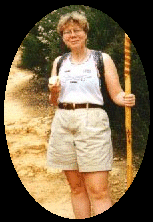
 Barbara Hambly born: 08-28-1951 in: San Diego, CA Homepage: http://www.barbarahambly.com Ms. Hamblys personal blog
Additional links:
|
Bibliography:
|
Considering the impressive bibliography of Barbara Hambly she is in no way a new author. But she was a new discovery for me when I found her books in a store in New Orleans. The Benjamin January mysteries take place in a time which is still quite alive in New Orleans today and about which many stories are told: 1833. After the death of his wife Benjamin January has returned to his hometown from Paris, where he practiced as a physician. Practicing is in no way possible for him now, so he has to fall back on his second gift: music. He earns a living as a teacher and playing at balls and parties. In Paris he was used to an unprejudiced handling of his person but now he has to get used again to live as a coloured person and obey the rules of society.
The novel lives from the time and the city it takes place in. This is a historical mystery at its best, well researched and with the skilful use of historical persons, buildings and their stories which are still told in New Orleans. When you know the city you will love this book. And when you've never been there you will become very curious about New Orleans. This is the first book of a series of which until now four volumes have been published and the next two have been announced. Which means that there still is a lot to read about Benjamin January. And about how people lived in 19th century New Orleans.
New Orleans is terrorized by a yellow fever epedemic. People who have the money already left town to wait for the epedemic to pass in a much healthier climate. In this times Benjamin January is needed as a doctor more than ever to ease the dying. Because in 1833 there was no real chance against yellow fever. But those who stay in town want to keep up their normal live as much as possible and therefore Benjamin still has some students for piano lessons.
Two historical figures which still play a central role in New Orleans history take part in this novel: one is Marie Laveau, the legendary Voodooienne. Ben meets her while tending to the sick and searching for the missing former slaves. The other is Madame LaLaurie, mother of Ben's piano students, who hides a terrible secret behind her humane facade: she is said to have tortured and cruelly experimented on numerous slaves in her attic. During his investigations Ben hears about these rumors regarding Madame LaLaurie again and again. But is a woman who looks after the sick so devotedly really able to do such terrible things?
In this novel legend and fiction are mixed together again expertly. Madame LaLaurie was a real person and there are still some old documents concerning the said happenings but nobody knows what really happened. It could have been the way Barbara Hambly describes it. On each page one can feel the atmosphere of New Orleans and see the streets and people alive in front of him/her, even when the story takes place in another century. But when it's about a good story, nobody in New Orleans cares anyway.
In the third part of the Benjamin January-series Benjamin has to concern himself with the problems of his own family. After all his sister is accused of being responsible for a murder. And to find out who is the source of this terrible accusation he has to get in touch with an important part of his own culture: Voodoo. As a free man of color who only wants to make a living as a physician or music teacher he would like to ignore this part of his culture... He knows that voodoo is an important reason for the mistrust the whites citizens have against the coloreds. If its convenient even the white people like to buy a gris-gris or a curse. But for the rest of the time this religion is the source of all evil in town. And those who practice voodoo, as Olympe and Marie Laveau do, can't be trusted at all. They may even be responsible for a senseless murder.
In contrast to both previous Benjamin novels this one has only one single storyline: solving the case of Olympe. The other novels were more eventful (and sometimes more confusing) because several things could happen at once and seperate storylines could suddenly be connected somehow. One can follow the single storyline of 'Graveyard Dust' quite easily but the book isn't as lively and turbulent as the previous parts. But it centers around one big theme which is illustrated extremely well: what it meant to be a slave or a free man of color in New Orleans. Feelings and reactions of the colored people are described well and it is possible to put oneself into their place and way of thinking. Or at least to try to do it.

"A lush and haunting novel of a city steeped in decadent pleasures ... and of a man, proud and defiant, caught in a web of murder and betrayal. It is 1833. In the midst of Mardi Gras, Benjamin January, a Creole physician and music teacher, is playing piano at the Salle d'Orleans when the evening's festivities are interrupted - by murder. Ravishing Angelique Crozat, a notorious octoroon who travels in the city's finest company, has been strangled to death. With the authorities reluctant to become involved, Ben begins his own inquiry, which will take him through the seamy haunts of riverboatmen and into the huts of voodoo-worshipping slaves. But soon the eyes of suspicion turn towards Ben - for, black as the slave who fathered him, this free man of color is still the perfect scapegoat ..."
But when a coloured society-girl is murdered and it seems that no one is interested in finding the murderer because he might be white, January starts his own investigations. Unfortunately he has to find the murderer not just out of his own curiosity, but because of his own survival while he becomes the main suspect.
[Dorothée Büttgen, January 01]

"The summer of 1833 has been one of brazen heat and brutal pestilence, as the city is stalked by Bronze John - the popular name for the deadly yellow fever epidemic that tests the healing skills of doctor and voodoo alike. Even as Benjamin January tends the dying at Charity Hospital during the steaming nights, he continues his work as a music teacher during the day. When he is asked to pass a message from a runaway slave to the servant of one of his students, January finds himself swept into a tempest of lies, greed, and murder that rivals the storms battering New Orleans. And to find the truth he must risk his freedom ... and his very life."
When in the general chaos of departure and dying more and more former slaves vanish from the city Ben looks into this. And he discovers not only a brutal slave trade but all the while risks his own live.
[Dorothée Büttgen, September 01]

"It is St. John's Eve in the summer of 1834 when Benjamin January - Creole physician and music teacher - is shattered by the news that his big sister has been arrested for murder. The Guards have only a shadow of a case against her. But Olympe - mystical and rebellious - is a woman of color, whose chance for justice is slim. As Benjamin probes the allegation, he is targeted by a new threat: graveyard dust sprinkled at his door, whispering of a voodoo death curse. Now, to save Olympe's live - and his own - Benjamin knows he must glean information wherever he can find it. For in the heavy darkness of New Orleans, the truth is what you make it, and justice can disappear with the night's warm breeze as easy as graveyard dust ..."
Rather sociocritical that criminalistic its not really the most thrilling Benjamin-novel, but an important mirror of the city of New Orleans and the time in which it takes place.
[Dorothée Büttgen, Juni 02]
More great reviews at Bookworm's Lair:



